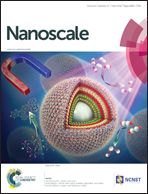Self-assembled SnO2 micro- and nanosphere-based gas sensor thick films from an alkoxide-derived high purity aqueous colloid precursor†
Abstract
Tin oxide is considered to be one of the most promising semiconductor oxide materials for use as a gas sensor. However, a simple route for the controllable build-up of nanostructured, sufficiently pure and hierarchical SnO2 structures for gas sensor applications is still a challenge. In the current work, an aqueous SnO2 nanoparticulate precursor sol, which is free of organic contaminants and sorbed ions and is fully stable over time, was prepared in a highly reproducible manner from an alkoxide Sn(OR)4 just by mixing it with a large excess of pure neutral water. The precursor is formed as a separate liquid phase. The structure and purity of the precursor is revealed using XRD, SAXS, EXAFS, HRTEM imaging, FTIR, and XRF analysis. An unconventional approach for the estimation of the particle size based on the quantification of the Sn–Sn contacts in the structure was developed using EXAFS spectroscopy and verified using HRTEM. To construct sensors with a hierarchical 3D structure, we employed an unusual emulsification technique not involving any additives or surfactants, using simply the extraction of the liquid phase, water, with the help of dry butanol under ambient conditions. The originally generated crystalline but yet highly reactive nanoparticles form relatively uniform spheres through self-assembly and solidify instantly. The spheres floating in butanol were left to deposit on the surface of quartz plates bearing sputtered gold electrodes, producing ready-for-use gas sensors in the form of ca. 50 μm thick sphere-based-films. The films were dried for 24 h and calcined at 300 °C in air before use. The gas sensitivity of the structures was tested in the temperature range of 150–400 °C. The materials showed a very quickly emerging and reversible (20–30 times) increase in electrical conductivity as a response to exposure to air containing 100 ppm of H2 or CO and short (10 s) recovery times when the gas flow was stopped.



 Please wait while we load your content...
Please wait while we load your content...